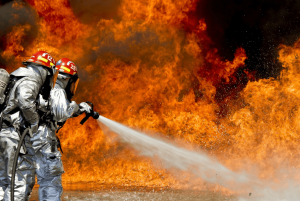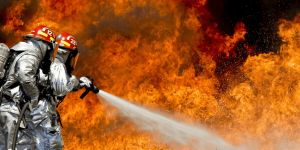In recent years and this year as well, there have been several reports in the media about landfills burning here and there again.

During our work, we experienced an interesting situation in this area.
In landfills, the delivered residential and commercial waste is treated, disposed of, selectively sorted and the materials produced are recycled or disposed of in accordance with the environmental protection authority's permit.
Specific fractions delivered to the landfill area must be placed according to the previously mentioned permit (specific material may be deposited; in a specific layer order; with specific compaction; covered with a specific covering material, etc.).
It is a regrettable situation that the aforementioned technology creates a mass of material prone to self-ignition in terms of fire protection, and here you have to think of hundreds of cubic meters, not a pile of wheelbarrows.
In the majority of landfill fires, the fire investigation typically names spontaneous combustion as the cause of the fire. This is not surprising, since in these areas there is not really a technology or device that would be the root cause, to be more precise, it happens in a very small number of cases, for example, that a fault in the vehicles carrying out compaction and transport, or in the electric air line running above the landfill, causes a fire in the material placed on the landfill and it must be extinguished, but the conditions for self-ignition are available.
During the above-mentioned technology, the applied material contains combustible material and organic components, during its compaction there remains a hollow and looser structural space filled with plenty of air, and the ingress of moisture cannot be excluded or ensured (on the one hand, because we are talking about an open space, on the other hand, the so-called leachate must be sprinkled back to the landfill: in accordance with the technological regulations necessary for the decomposition of deposited materials and the development of landfill gas).
The National Fire Protection Regulations deal with the fire protection of substances prone to self-ignition in a rather "general" way. It does not provide a specific solution to prevent the spontaneous combustion process from occurring:
"(4) A substance prone to self-ignition must not be stored in the same unit with other substances belonging to the explosive and flammable classes, as well as substances whose interaction can generate heat, fire or explosion. The temperature of the material prone to self-ignition must be checked daily or - if the properties of the material make it necessary - continuously, and dangerous heating must be prevented. "
According to the law, the inspection can be said to be almost continuous: there are practically always workers at the landfill during the relevant period (working hours), and during the non-working period, the patrols of the security service providing the protection of the sites require an obligation every two hours, therefore the inspection can be considered continuous.
Taking into account the above, the start of the self-ignition process cannot be ruled out by continuous monitoring, at most the start of the process, which can be enveloped in the first place, can be detected in the early period.
If the process of self-ignition has been detected, some intervention is made to prevent a surface fire.
As a rule, covering or a more concentrated distribution of leachate is used. It is not really possible to turn over the pile of material at the landfill due to the amount of material created by the dumping.
A very complex problem emerges, for which, in our opinion, there is currently no effective solution based on the following:
- the waste produced and generated by the population, among you, during daily life must be delivered;
- delivered waste must be treated and disposed of as already outlined (waste management carried out on the basis of official permits);
– the treatment technology causes the process of auto-ignition from the very beginning (we produce a material prone to auto-ignition and store it under the conditions of auto-ignition);
- self-ignition cannot be ruled out, taking into account the principles of utilization (decomposition of waste and utilization of the resulting biogas as much as possible);
The relevant authorities are whipping the plant operators to find a solution to the fires that occurred during the above process. The fire department is conducting official inspections, imposing a fire protection fine or reimbursing evacuation costs., but does not come up with a specific proposal.
The environmental protection authority solved the issue more simply, because based on the relevant legislation, it is actually interested in the data of the fire incident, on the basis of which it can calculate the fine that can be imposed in the first place:
"306/2010. (XII. 23.) Government decree
(2) It is prohibited to burn waste in open spaces or in equipment that does not comply with the legislation setting out the conditions for burning waste, with the exception of household waste paper and non-hazardous, untreated wood waste in household equipment. It is considered open waste burning if the waste - with the exception of elemental damage - catches fire for any reason."
Annex No. 9 of the same legislation contains the methodology for calculating the fine, according to which:
- It does not prevent the self-ignition or ignition of the waste and material storage or waste, and it does not provide for extinguishing (in the case of quantities over 10 m3); HUF 500,000
- Failure to prevent self-ignition or ignition of waste and material storage or waste, or failure to extinguish it (in the case of quantities of up to 10 m3); HUF 100,000
A poetic question arises in us: How ethical is it?
– business to impose fines, that the authority that prescribes what kind of material, how and where to dump it, and what technology to do all of this fines. Ergo produces a mass of material prone to self-ignition and deposits it in such a way that self-ignition is only a matter of time.
– when the material treated as prescribed by him ignites spontaneously, due to the reasons described above, this process cannot be ruled out. So, for not preventing self-immolation, he also imposes a fine.
Final thought:
The disaster prevention and environmental protection authorities do not establish any irregularities in connection with the production and handling of the material or the implementation of the technology used during landfill fires.





